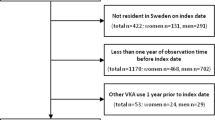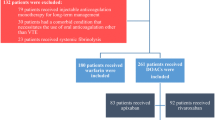Abstract
Although the risk for bleeding during long-term warfarin therapy is established, little is known about the clinical impact following warfarin-associated bleeding and the management of anticoagulant resumption after a bleed. We performed a retrospective chart review of patients who suffered a warfarin-associated bleed that required hospitalization or that occurred during hospitalization. We determined the proportion of patients who required a blood product transfusion, a surgical or other invasive procedure or admission to an intensive care unit, and the duration of hospitalization. We also determined the case-fatality rate of bleeding and described post-bleed resumption of anticoagulation. We studied 142 patients (70 women) hospitalized with warfarin-associated bleeding with a mean age of 73 years. The most prevalent sites of bleeding were the gastrointestinal tract (40.8%) and urinary tract (14.1%). Of all bleeding episodes, 72 (50.1%) were classified as major bleeds. There were 66 (46.4%) patients who required either endoscopy, surgery or admission to an intensive care unit, and the mean duration of hospitalization was 23 days. The case fatality rate of major bleeding was 9.5%. Among patients in whom warfarin was restarted, 8.3% suffered recurrent bleeding. Warfarin-associated bleeding appears to confer considerable morbidity related to transfusion and hospitalization, approximately 1 in 10 major bleeds are fatal, and 1 in 12 patients will re-bleeding after warfarin resumption.
Similar content being viewed by others
References
Wysowski DK, Swartz L (2007) Bleeding complications with warfarin use: a prevalent adverse effect resulting in regulatory action. Arch Intern Med 167:1414–1419
Palaretti G, Leali N, Coccheri S et al (1996) Bleeding complications of oral anticoagulant treatment: an inception-cohort, prospective collaborative study (ISCOAT). Study on complications or oral anticoagulant therapy. Lancet 348:423–428
Fihn SD, McDonell M, Martin D et al (1993) Risk factors for complications of chronic anticoagulation. A multicenter study. Ann Intern Med 118:511–520
Schenk JF, Morsforf S, Pindur G et al (1999) Analysis and occurrence of adverse events with oral anticoagulation therapy. Semin Thromb Hemost 25:65–71
Landefeld CS, Beyth RJ (1993) Anticoagulation-related bleeding: clinical epidemiology, prediction, and prevention. Am J Med 95:315–328
Connolly SJ, Ezekowitz MD, Yusuf S et al (2009) Dabigatran versus warfarin in patients with atrial fibrillation. N Engl J Med 361:1139–1151
Executive Steering Committee; on behalf of the SPORTIF III Investigators (2003) Stroke prevention with the oral direct thrombin inhibitor ximelagatran compared with warfarin in patients with non-valvular atrial fibrillation (SPORTIF III): randomised controlled trial. Lancet 362:1691–1698
Executive Steering Committee; for the SPORTIF V Investigators (2005) Ximelagatran vs warfarin for stroke prevention in patients with nonvalvular atrial fibrillation: a randomized trial. JAMA 293:690–698
Van der Meer FJM, Rosendaal FR, Van der Broucke JP, Briet E (1993) Bleeding complications in oral anticoagulation therapy. Arch Intern Med 153:1557–1562
Spencer FA, Gore JM, Lessard D, Douketis JD, Emery C, Goldberg RJ (2008) Patient outcomes after deep vein thrombosis and pulmonary embolism: the Worcester Venous Thromboembolism Study. Arch Intern Med 168:425–430
Douketis JD, Arneklev K, Goldhaber SZ, Spandorfer J, Horrow J (2006) Comparison of bleeding in patients with nonvalvular atrial fibrillation treated with ximelgatran or warfarin. Assessment of incidence, case fatality rate, time course, anatomic sites and risk factors for bleeding. Arch Intern Med 166:853–859
Linkins LA, Choi P, Douketis JD (2003) Clinical impact of bleeding in patients taking oral anticoagulation therapy for venous thromboembolism: a meta analysis. Ann Intern Med 139:893–900
Carrier M, Le Gal G, Wells PS, Rodger MA (2010) Systematic review: case-fatality rates of recurrent venous thromboembolism and major bleeding events among patients treated for venous thromboembolism. Ann Intern Med 152:578–589
Punthkee X, Doobay J, Annd SS (2002) Oral-anticoagulation-related intracerebral hemorrhage. Thromb Res 108:31–36
Hylek EM, Singer DE (1994) Risk factors for intracranial haemorrhage in outpatients taking warfarin. Ann Intern Med 120:897–902
Douketis JD, Berger PH, Dunn AS et al (2008) The perioperative management of antithrombotic therapy: American College of Chest Physicians Evidence-Based Clinical Practice Guidelines (8th edition). Chest 133(6 Suppl):299S–339S
Douketis JD, Gu CS, Schulman S, Ghirarduzzi A, Pengo V, Prandoni P (2007) The risk for fatal pulmonary embolism after discontinuing anticoagulant therapy for venous thromboembolism. Ann Intern Med 147:138–143
Claassen DO, Kazemi N, Zubkov AY et al (2008) Restarting anticoagulation therapy after warfarin-associated intracerebral hemorrhage. Arch Neurol 65:1313–1318
Hawryluk GW, Austin JW, Furlan JC et al (2010) Management of anticoagulation following central nervous system hemorrhage in patients with high thromboembolic risk. J Thromb Haemost 8:1500–1508
Kawamata T, Takeshita M, Kubo O et al (1995) Management of intracranial hemorrhage associated with anticoagulant therapy. Surg Neurol 44:438–442
Ananthasubramaniam K, Beattie JN, Rosman HS et al (2001) How safely and for how long can warfarin therapy be withheld in prosthetic heart valve patients hospitalized with a major hemorrhage? Chest 119:478–484
Amlani S, Nadarajah T, Afzal R et al (2010) Mortality and morbidity following a major bleed in a registry population with acute ST elevation myocardial infarction. J Thromb Thrombolysis 30:434–440
Eikelboom JW, Quinlan DJ, O’Donnell M (2009) Major bleeding, mortality, and efficacy of fondaparinux in venous thromboembolism prevention trials. Circulation 120:2006–2011
Author information
Authors and Affiliations
Corresponding author
Rights and permissions
About this article
Cite this article
Guerrouij, M., Uppal, C.S., Alklabi, A. et al. The clinical impact of bleeding during oral anticoagulant therapy. J Thromb Thrombolysis 31, 419–423 (2011). https://doi.org/10.1007/s11239-010-0536-7
Published:
Issue Date:
DOI: https://doi.org/10.1007/s11239-010-0536-7




